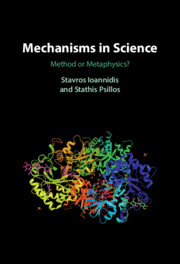Book contents
- Mechanisms in Science
- Mechanisms in Science
- Copyright page
- Dedication
- Contents
- Figures
- Preface
- Introduction
- Part I Ideas of Mechanism
- Chapter 1 Mechanisms, Then and Now
- Chapter 2 Extending Mechanism beyond the Two ‘Most Catholic Principles of Bodies’
- Part II Causation and Mechanism
- Part III Beyond New Mechanism
- Finale
- References
- Index
Chapter 1 - Mechanisms, Then and Now
from Part I - Ideas of Mechanism
Published online by Cambridge University Press: 09 June 2022
- Mechanisms in Science
- Mechanisms in Science
- Copyright page
- Dedication
- Contents
- Figures
- Preface
- Introduction
- Part I Ideas of Mechanism
- Chapter 1 Mechanisms, Then and Now
- Chapter 2 Extending Mechanism beyond the Two ‘Most Catholic Principles of Bodies’
- Part II Causation and Mechanism
- Part III Beyond New Mechanism
- Finale
- References
- Index
Summary
Chapter 1 examines the relationship between Old and New Mechanism and uses it to illuminate the relations between metaphysical and methodological conceptions of mechanism. This historical examination will directly motivate our new deflationary account of mechanism developed in the subsequent chapters. We start by focusing on the role of mechanistic explanation in seventeenth-century scientific practice, by discussing the views of René Descartes, Christiaan Huygens, Gottfried Wilhelm Leibniz and Robert Boyle, and the attempted mechanical explanations of gravity by Descartes and Ηuygens. We thereby illustrate how the metaphysics of Old Mechanism constrained scientific explanation. We then turn our attention to Isaac Newton’s critique of mechanism. The key point is that Newton introduced a new methodology that freed scientific explanation from the metaphysical constraints of the older mechanical philosophy. Last, we draw analogies between Newton’s critique of Old Mechanism and our critique of New Mechanism. The main point is that causal explanation in the sciences is legitimate even if we bracket the issue of the metaphysics of mechanisms.
Keywords
- Type
- Chapter
- Information
- Mechanisms in ScienceMethod or Metaphysics?, pp. 15 - 39Publisher: Cambridge University PressPrint publication year: 2022

